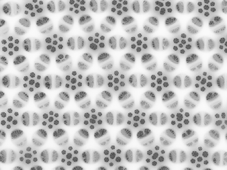The highly siliceous cell walls of diatoms are probably the most outstanding examples of nanostructured materials in nature. Previous in vitro experiments have shown that the biomolecules found in the cell walls of diatoms, namely polyamines and silaffins, are capable of catalysing the formation of silica nanospheres from silicic/oligosilicic acid solutions. In a previous publication, silica precipitation was found to be strictly correlated with a phosphate-induced microscopic phase separation of the polyamines. The present contribution further characterises the phase separation behaviour of polyamines in aqueous solutions. In particular, a pronounced pH-dependence of the average particle diameter is found. It is, furthermore, shown that the ability of phosphate ions to form polyamine aggregates in aqueous solutions cannot be a purely electrostatic effect. Instead, a defined hydrogen-bonded network stabilised by properly balanced electrostatic interactions should be considered. Finally, solid-state 31P NMR studies on phase-separated polyamines, synthetic silica precipitates, and diatom cell walls from the species Coscinodicus granii support the assumption of a phosphate-induced phase separation process taking place during cell wall formation.

You have access to this article
 Please wait while we load your content...
Something went wrong. Try again?
Please wait while we load your content...
Something went wrong. Try again?


 Please wait while we load your content...
Please wait while we load your content...